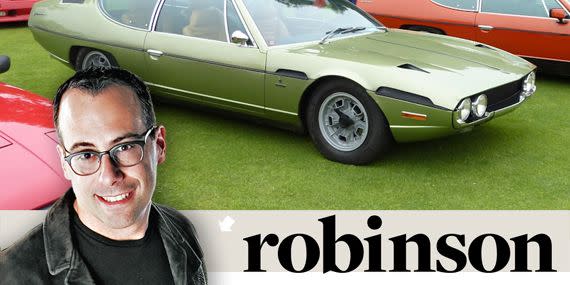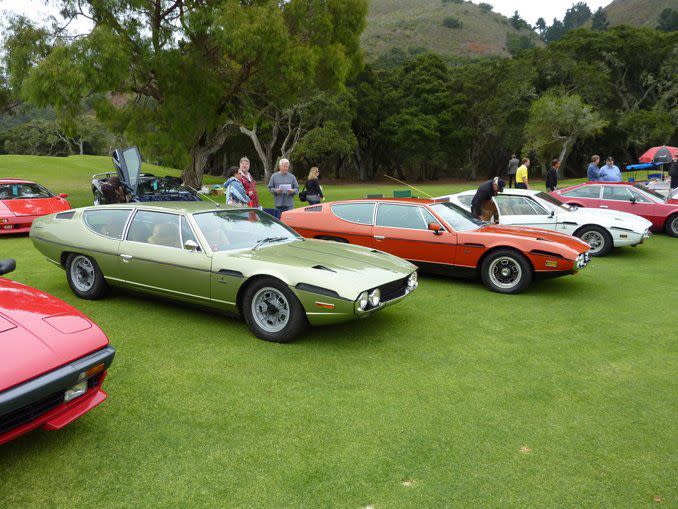The Curtain Rises on Yet Another Epic Battle With an Italian Original



I knew the car was coming home with me the minute I saw the spare tire. Yes, the spare. All spare tires are pretty much the same; they’re round, usually black, and generally made of rubber. Some even have air in them.
So why was this one special? It was the original Pirelli Cinturato spare tire from the factory. In fact, it looked like it had never been out of the car. There was grease-pencil writing on the sidewall—incomprehensible gibberish, but original incomprehensible factory gibberish. My knees turned to jelly.
Perhaps I should disclose that the car in question is a 41-year-old Lamborghini Espada, a four-seat, V-12–powered autostrada eater of which just 1217 were built. To an Espada nerd, finding original grease-pencil writing on the spare tire is like finding a handwritten score for Puccini’s Turandot tucked inside a pawn-shop violin. I told the owner, a retired IBM executive, that I would be back in two weeks with a bank check and a trailer.
Originality is everything to an old-car buyer. It is the fullest and most unsullied expression of the virgin item. It is America before the white man, Jerusalem before the Romans, Eden before Adam and Eve cut holes in it to install a killer stereo. To buy an original car is to touch the face of the creator. It’s like being Facebook friends with Ferruccio Lamborghini’s ghost.
This Espada was indeed authentic. Besides having a full pristine set of cast magnesium wheels with their three-ear knockoff spinners, both tool bags were there. The matched set of locking gas caps, often lost, was still there, as was the single key. The rare “Bertone” dash placard—only found on the first few of the Series 2 Espadas and usually missing—was still there.
(I once spent seven years restoring an Espada, so I know my way around these cockeyed cars. Being an Espada scholar won’t win me a Kluge Prize for intellectual achievement, but at least I’m an expert in something. Most people can’t say that.)
This car had resided with the same owner for 36 years, which is quite unusual. This is because old Lamborghini Espadas spend all day and night sitting in their garages inventing new and insidious ways to bankrupt their masters. Thus, they tend to go through a lot of them, sucking their hapless victims pale before shuffling on to fresh meat. They are the automotive embodiment of the Princess Turandot, who lures young princes to their death with her beauty and her riddles.
The stamp of originality only further bedevils an Espada owner, being both a blessing and a millstone around his neck. What do I mean?

Say, for example, the wire-brush wheel yanks the bolt you are cleaning from your hand and flings it at hypersonic speed across the garage, its trajectory discernible only by the soft “plink!” of it hitting the floor somewhere distant. If the bolt isn’t original, you just take another from your box and carry on. If it is, you squander the next few hours searching for it with a klieg light and a magnetic stick, poking under workbenches where hairy brown spiders hang out in the dust and cobwebs.
One of my Espada’s four periwinkle-blue leather seats is cracked and dry-rotted. I can always reupholster it, but in order for it to match the other three, I must reproduce the leather’s original perforation pattern, which looks like Martian hieroglyphics. To do that, I have to send the new, unstitched leather to a man in Italy who runs it through the special hole-punching machine. Including labor, shipping, and customs duty, it runs about $2000. For holes.
The car’s original and rare “Verde Pallido” (basically, snot-green) paint is cracking in a few places. Do I repaint the car or accept its decaying patina as original? At what point does original become ghetto?
These are some of the nagging conundrums faced by owners of original cars. Indeed, is an original car even a car, or has it become an irreplaceable historical artifact? Are you the owner or just the current curator? Will future generations curse you for the tiny alterations you make for convenience or to save a few filthy pennies? Does it even matter when you’re talking about an Espada, the VW Squareback of Italian exotics?
Most of the people I know said I was crazy for buying another Espada. They said it was like going to the dog pound after a pit-bull attack and adopting a wolverine. I can’t argue. The Espada is my Turandot; either I solve her riddles for love or I die trying.
Soon after my original snot-green/periwinkle-blue Espada came home, I learned that the engine had to come out in order to fix a terminal problem. Why can’t the riddles ever be easy? As the disgorged V-12 hung on the cherry-picker chains, I noticed that one of the cylinder heads has a casting date that is exactly the same as my birthday. Not only is the vehicle original, but the car and I are bound together by actual dates of origin. There is no turning back.
“Vincerò, vincerò, vincerò!” trills Prince Calàf in Turandot’s famous aria, Nessun Dorma. “I will win, I will win, I will win!”
You Might Also Like

 Yahoo Autos
Yahoo Autos 